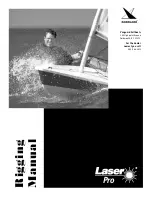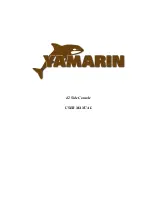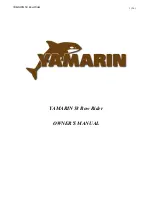
Note:
When boat is equipped with two shore power
inlets (has both the Cabin and Helm Deck A/C),
the bottom inlet is Shore Power 2 and will only
feed power to the Cabin A/C unit. Shore Power 1
will need to remain energized in order to provide
cooling water to the A/C pump which feeds
cooling water to both Helm and Cabin A/C units.
Do not use a shore power source with reversed
polarity. Disconnect the shore power cord
immediately from the shore power source when
reverse polarity is indicated.
M. Inverter (optional) Operation
(Fig_6.2-11)
The inverter is located on the starboard side of the
engine room. (see Fig_6.2-11)
The “AC Sub Panel” circuits are powered by the
inverter. The inverter is controlled from a switch just
outboard of the distribution panel.
N. Generator
(optional)
Operation
(Fig_6.2-10)
The generator is located on the port side in the
engine room. (see Fig_6.2-10) The generator is
operated by a control switch located outboard of the
distribution panel (see Fig_6.2-4), see generators
owner’s manual for proper use.
Power is feed from the generator to a 30Amp dual-
pole breaker on the aft engine room bulkhead, to the
generator/ shore power selector (barrel) switch on the
AC electrical distribution panel (see Fig_6.2-5). Either
the generator or shore power is fed to the 120V AC
circuits by using this switch.
Note:
If boat is equipped with a generator and both A/C
(Cabin and Helm) units, the barrel switch
provides power to both shore power branch
circuits. Allowing either A/C unit to be run by the
generator.
Power consumption will have to be monitored or
the generator breaker in the engine room will trip.
Note:
Before starting generator, open the water intake
sea valve, exhaust sea valve and inspect raw
water strainer for blockage.
Generator will lose fuel supply before tank is
empty. The fuel supply system is designed to
prevent a running generator from emptying the
fuel tank. It is the responsibility of every captain
to monitor the vessel’s fuel level and ensure that
enough fuel is on board to safely operate the
vessel’s machinery.
O. Bonding
System
The Back Cove 30 has a bonding system designed to
minimize the differences in electrical potential
between all fittings. Both the 12V DC and 120V AC
systems connect to the bonding system. The 120V
AC system is tied in through the safety ground (green
wire).
The bonding system connects significant fittings and
components to a sacrificial zinc anode mounted on
the transom. (see Fig_6.2-19) Other sacrificial zinc
anodes are installed on the trim tabs, and each side
of the rudder. The yard may have installed additional
zinc (on the prop shaft) during commissioning. Items
in the system include the engine, swim platform
brackets, potentially electrically connected thru-hulls,
rudder, strut, propeller shaft, and deck fuel fill plate.
The fuel fill is included to minimize static electricity-
induced sparks. Any new potentially electrically
connected underwater fitting(s) installed on the boat
should be linked to the bonding system to maintain
proper operation and to minimize corrosion.
Summary of Contents for Back Cove 30
Page 1: ...Back Cove 30 Owner s Manual...
Page 30: ...5 0 V e s s e l O v e r v i e w 5 1 General Arrangement Cockpit Helm Deck Cabin...
Page 35: ...5 3 Mechanical Overview Lazarette Engine Room Forward Bilge Zone...
Page 61: ...Fig_6 12c 7 Fig_6 12c 8 Companionway Fig_6 12c 9 Mate Seat Footrests Companionway Catch s...















































